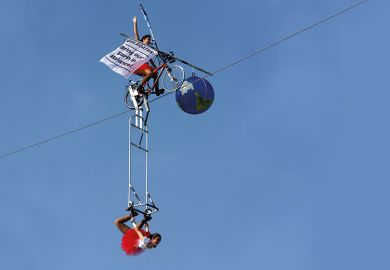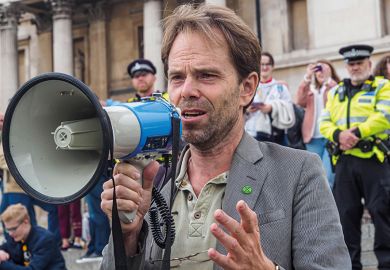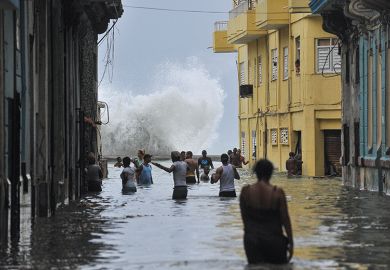For Fernando Reimers, the opening conference of the Harvard University Centre for the Environment was “eye-opening”.
“It was mostly scientists, and I came away thinking: ‘No wonder we have a problem! These people talk only to themselves, [and] publish in journals only they can access,’” said Professor Reimers, Ford Foundation professor of practice in international education at Harvard’s Graduate School of Education. “My takeaway from that conference was that we need to connect the education community with that community of scientists.”
By this point, Professor Reimers had spent 15 years on civic engagement and global citizenship education, developing curricula to align the United Nations’ Sustainable Development Goals.
But the insights that he drew from the event are the central premise of a project-based activity he introduced into a course on educational policy and now a book. In Professor Reimers’ opinion, most attempts to teach climate change neglected “the best knowledge or science about how you educate people to change their behaviour” and were based on a belief that “a top-down process of transmitting the facts is enough”.
“It’s the assumption of many scientists: if you know the facts, the facts will redeem you,” he said. “What the field of civic education teaches you is that you also need to cultivate dispositions and attitudes, and then to provide skills development...Just giving young people knowledge about climate change may be counterproductive, because it can drown them in a sense that it is all so complicated and overwhelming there is nothing they can possibly do.”
In order to address such issues head-on, Professor Reimers incorporated a project-based approach into the course he teaches on educational policy to about 65 international students, including both teachers and those working in local educational authorities or at a system level within their national educational sectors. The course also forms the basis for the forthcoming collection Education and Climate Change: The Role of Universities (Springer).
Each student on the master’s, he explained, has to “create a partnership with a school, a not-for-profit that works with schools or a government. In a semester-long course, they begin by asking: How is climate change impacting this place? Which populations are most impacted? What should people learn if we want to diminish that impact? What is the best channel to reach them?”
Once they have thought through these issues, the students develop curricula, workshop them remotely with the teachers on the ground and then hone them in response to feedback. The result, in each case, is a set of materials that is perfectly adapted to a particular context but can also help stimulate similar projects elsewhere.
The case studies published in Education and Climate Change are truly global. Two of his students, Professor Reimers said, “worked with the Arava Institute in Israel, which is all about building peace between Israelis and Palestinians around climate change but had never before connected with schools”. Two others formed a partnership with a school in the highlands of Guatemala, based in a largely Indigenous community, and a local not-for profit environmental organisation.
In Guatemala, reported Professor Reimers, “the national curriculum is quite adept at including material about climate change, but it is just not happening. My students looked at that and saw the standards were already there. They also looked at a Unesco guide, which stresses engaging the whole school in a range of activities that create synergies but says nothing about curricula. The students took two existing things which weren’t working by themselves and collaborated with local teachers to build on them and create something that did.”
In another chapter in Education and Climate Change, Natasha Japanwala describes programmes for out-of-school young people in a rural area of Pakistan where literacy levels are low and “the local economy is…threatened by the salinisation of land as well as an increased risk to flooding”. The solution was a form of “project-based learning” that enabled young people to “work in teams, building their social and collaborative skills, to develop their own solutions and recognize the power of their own voice to advocate for their rights”.
Although universities clearly need to do many other things to engage with climate change, Professor Reimers saw vast potential in initiatives such as his.
“If only 10 per cent of the more than 20,000 institutions of higher education around the world engaged only one professor each year” in curriculum development projects, he points out in his book, and each involved just “five teams of students in the design of approaches to climate change education”, this would generate “10,000 context-specific strategies which could be offered to local coalitions for validation, adaptation, implementation and evaluation”.
This might well “exceed all the resources created by all international development institutions to support climate change education since the United Nations Sustainable Development Goals were adopted in 2015”.
POSTSCRIPT:
Print headline: ‘Just the facts’ won’t do: we must ‘cultivate’ corps to tackle climate change
Register to continue
Why register?
- Registration is free and only takes a moment
- Once registered, you can read 3 articles a month
- Sign up for our newsletter
Subscribe
Or subscribe for unlimited access to:
- Unlimited access to news, views, insights & reviews
- Digital editions
- Digital access to THE’s university and college rankings analysis
Already registered or a current subscriber?








